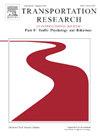An integrated autonomous vehicles acceptance model: Theoretical development and results based on the UTAUT2 model
IF 3.5
2区 工程技术
Q1 PSYCHOLOGY, APPLIED
Transportation Research Part F-Traffic Psychology and Behaviour
Pub Date : 2025-04-25
DOI:10.1016/j.trf.2025.04.015
引用次数: 0
Abstract
Several studies have examined acceptance of autonomous vehicles (AVs) by applying the Unified Theory of Acceptance and Use of Technology 2 (UTAUT2) model and extending it with factors applicable to AV acceptance. However, this has resulted in a multitude of factors with mixed findings about their impact. This study develops and validates an integrated UTAUT2 model for AV acceptance by conducting a systematic quantitative review of the AV studies that have extended the UTAUT2 model. From the initially identified 298 studies, 28 met the eligibility criteria and were analyzed to identify the most studied external factors, which the results revealed as perceived risk, perceived safety, trust in technology, innovativeness, and price sensitivity. An integrated UTAUT2 model including these factors was proposed and then validated by collecting and analyzing data from 402 respondents. The partial least squares-structural equation modeling (PLS-SEM) results showed that trust in technology was the most influential predictor of AV acceptance, followed by innovativeness, performance expectancy, perceived safety, hedonic motivation, social influence, and price sensitivity. Evidence was not found to support the impact of perceived risk, effort expectancy, and price value on AV acceptance. This integrated model offers a foundation for further AV acceptance research. The study also provides a more nuanced understanding about the factors influencing AV acceptance to guide policy makers and practitioners in devising effective AV adoption strategies.
一种集成的自动驾驶汽车验收模型:基于UTAUT2模型的理论发展与结果
一些研究通过应用技术接受和使用统一理论2 (UTAUT2)模型,并将其扩展为适用于自动驾驶汽车接受的因素,来检验自动驾驶汽车(AV)的接受程度。然而,这导致了许多因素对其影响的不同发现。本研究通过对扩展UTAUT2模型的AV研究进行系统的定量回顾,开发并验证了AV接受的综合UTAUT2模型。从最初确定的298项研究中,有28项符合资格标准,并对其进行了分析,以确定研究最多的外部因素,结果显示为感知风险,感知安全性,对技术的信任,创新性和价格敏感性。提出了一个包含这些因素的综合UTAUT2模型,然后通过收集和分析402名受访者的数据进行验证。偏最小二乘结构方程模型(PLS-SEM)结果显示,对技术的信任是自动驾驶汽车接受度的最重要预测因子,其次是创新性、性能期望、感知安全性、享乐动机、社会影响力和价格敏感性。没有证据支持感知风险、努力预期和价格价值对AV接受度的影响。该综合模型为进一步开展自动驾驶汽车接受研究奠定了基础。该研究还对影响自动驾驶汽车接受度的因素提供了更细致的了解,以指导政策制定者和从业者制定有效的自动驾驶汽车采用策略。
本文章由计算机程序翻译,如有差异,请以英文原文为准。
求助全文
约1分钟内获得全文
求助全文
来源期刊
CiteScore
7.60
自引率
14.60%
发文量
239
审稿时长
71 days
期刊介绍:
Transportation Research Part F: Traffic Psychology and Behaviour focuses on the behavioural and psychological aspects of traffic and transport. The aim of the journal is to enhance theory development, improve the quality of empirical studies and to stimulate the application of research findings in practice. TRF provides a focus and a means of communication for the considerable amount of research activities that are now being carried out in this field. The journal provides a forum for transportation researchers, psychologists, ergonomists, engineers and policy-makers with an interest in traffic and transport psychology.

 求助内容:
求助内容: 应助结果提醒方式:
应助结果提醒方式:


